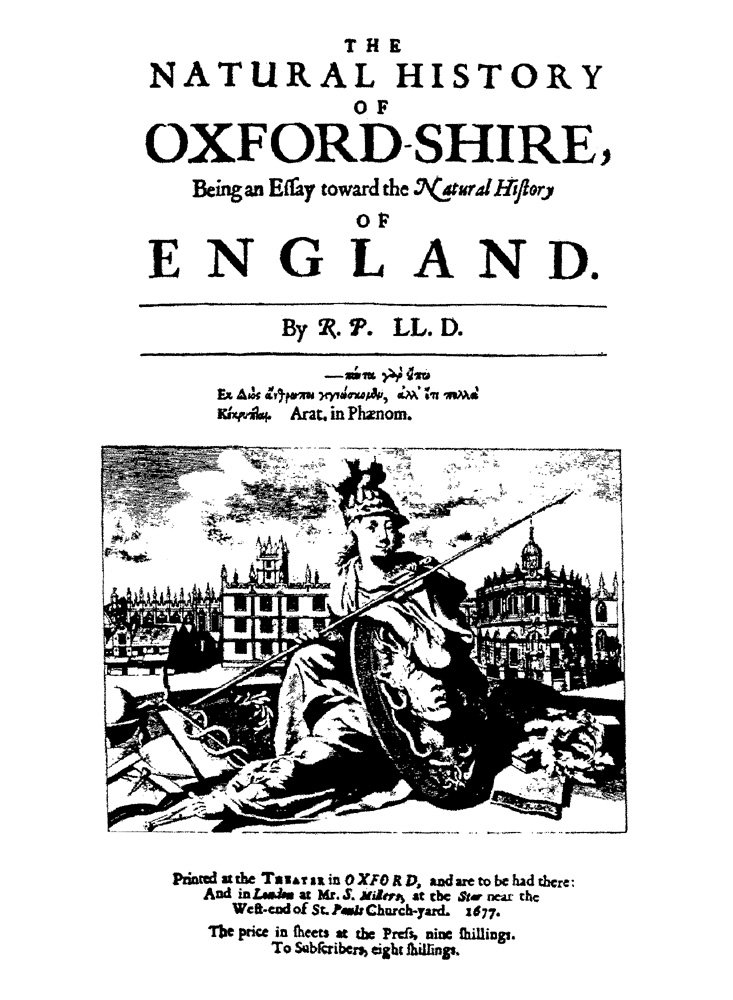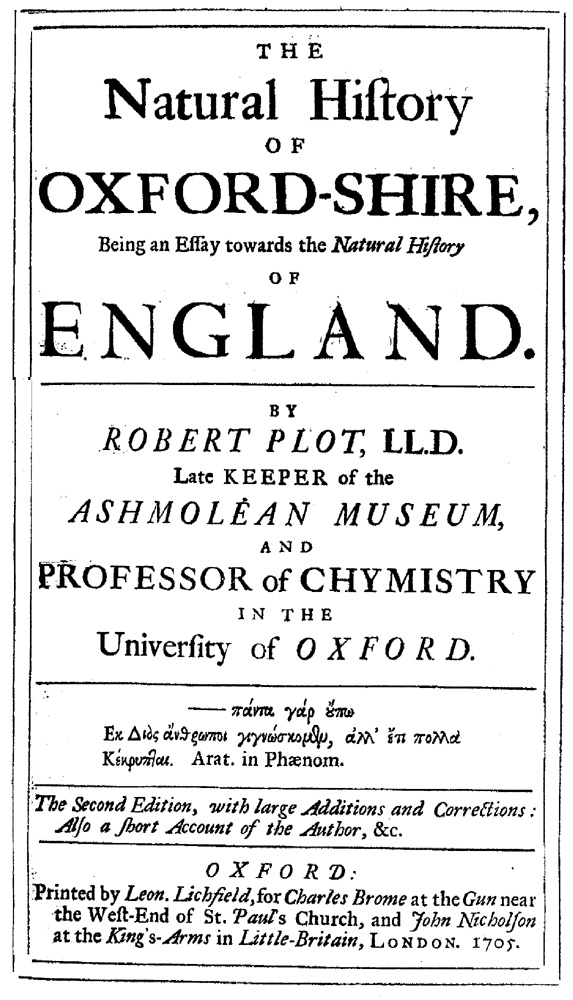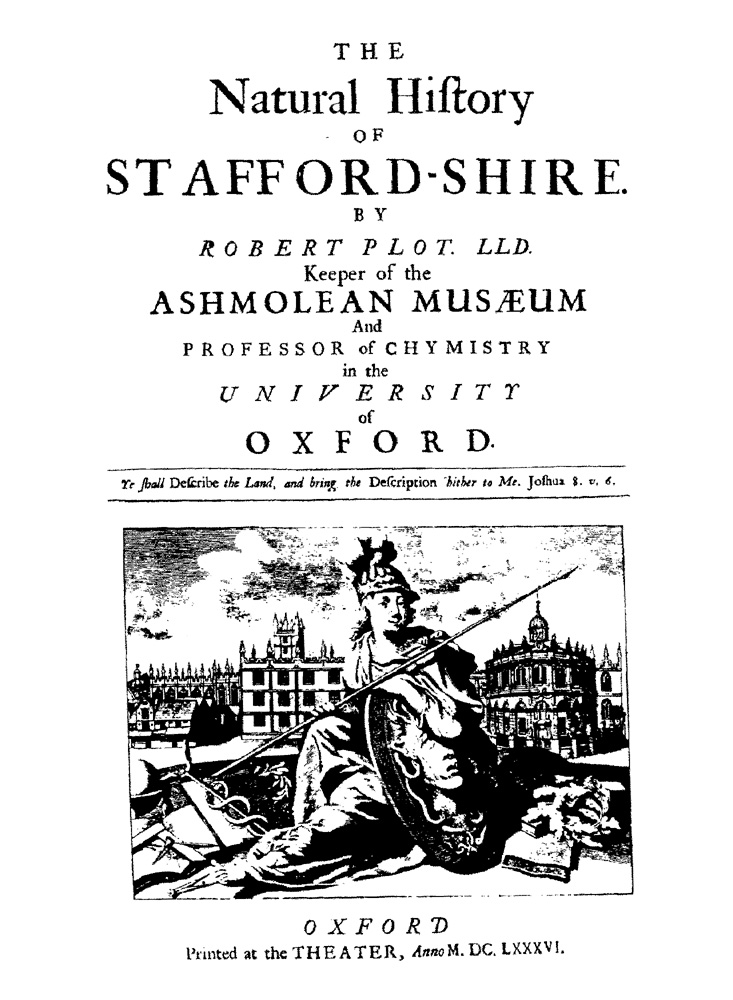PLOT, Robert.
(1640 – 1696)
Plot was a gentleman of property in Kent. He studied at Oxford, receiving a degree in 1671. He developed an interest in the natural sciences, and he became an omnivorous gatherer of specimens and observations in the Baconian tradition. . In 1683, he was appointed the `custos' of the Ashmolean Museum and professor of chemistry at the University of Oxford. He became historiographer royal in 1688 and Mowbray herald extraordinary in 1695. Plot was secretary of the Royal Society from 1682 to 1684 and again in 1692.
Biographical references: Allibone, Dictionary of English Literature, 1859-71. • BBA: I 882, 131-166. • Cleevely, World Palæontological Collections, 1983: 233. • DNB: 15, 1311-2. • DSB: 11, 40-1 [by A.G. Keller]. • Encyclopaedia Britannica, 11th edition. • Harley, J.B., "John Strachey of Somerset: an Antiquarian Cartographer of the early 18th Century", Cartographic Journal, 3, (1966), 2-7 [Plot is discussed]. • ISIS, 1913-65: 2, 336. • Lambrecht & Quenstedt, Catalogus, 1938: 341. • Paffard, M., "Robert Plot: A County Historian", History Today, 20, (1970), 112-7. • Poggendorff: 2, col. 474. • Sarjeant, Geologists, 1980: 3, 1902-3, Suppl. 1 (1986), 2, 704 & Suppl. 2 (1996), 2, 991. • Sollas, Age of the Earth, 1901: 227-34. • Taylor, F.S., "Alchemical Papers of Robert Plot", Ambix, 4, (1949), 67-76. • Watt, Bibliotheca Britannica, 1824. • WBI. • World Who's Who in Science: 1355.

1. English, 1677 [First edition].
The | Natural History | Of | Oxford-Shire, | Being an Essay toward the Natural History | Of England. | [rule] | By R.P. LL.D. | [rule] | [...3 lines of quotation in Greek...] | [vignette] | Printed at the Theater in Oxford, and are to be had there: | and in London at Mr. S. Millers, at the Star near the | West-end of St. Pauls Church-yard. 1677. | The price in sheets at the Press, nine shillings. | To Subscribers, eight shillings.
2°: π2 b4 A-Z4 Aa-Yy4 Zz2 Aaa-Bbb2; 193l.; [12], [1]-358, [12] p., large engraved device on title, and engraved arms and initial in dedictation ot Charles II. Page size: 312 x 195 mm.
Contents: [2 pgs], Blank, verso "Imprimatur hic Liber, ..."; [2 pgs], Title page, verso blank.; [2 pgs/=b1r-b1v], Dedication to Charles the Second.; [5 pgs/=b2r-b4r], "To the Reader."; [1 pg/=b4v], Blank.; [1]-358, Text.; [1 pg/=Yy4r], "Errata."; [1 pg/=Yy4v], Blank.; [10 pgs/Zz1r-Bbb1v], "The | Index."
Plates: A large folding map and 16 engraved plates by Micahel Burghers. Each plate has a dedication within an elaborate cartouch addressed to the owner of the land where the illustrated specimens were found.
Very scarce. The classic Baconian "Natural History", a systematic gathering of information and observations on the flora, fauna, geology, paleontology and intellectual history of Oxfordshire. Plot's botanical descriptions have been highly praised, and he had some notion of stratigraphy and described and illustrates a variety of fossils (and some minerals), including a large fossil quadruped bones. He also gives a detailed account of Oxford science, arguing in some detail that Roger Bacon was the true inventor of the telescope, and reviewing the inventions and discoveries of Wilkins, Wallis, Boyle, Hooke, Halley, and others. On the strength of this book, Plot was elected a Fellow of the Royal Society.
The History of Oxfordshire is a very interesting work, full of queer old-world information, quaint digressions, and pleasant meandering, winding gently on each side of the main discourse. It contains a map of Oxfordshire curiously bordered round with the arms of the resident nobility and gentry, and each of its excellent plates of illustrations bears a dedication in the corner to some noble patron, with the emblazonment of his arms.
Dr. Plot was evidently acquainted with the views of Steno, but he did not share them; on the contrary, he met them with a strenuous Opposition, in which he displayed great resources of learning and dialectic skill. A whole chapter of the History is devoted to the description of the Fossils, or, as they are there termed, the "Formed Stones" of the county. It is illustrated by engravings which, for truthfulness, leave little to be desired, so that, even at this distance of time, there is little difficulty in recognizing and identifying the different genera or even species that they represent.
The stones to which Dr. Plot first directs attention are those that stand in some connection with the heavenly bodies, such as the Sun-stone, of which, however, there are none in Oxfordshire; the Moon-stone, or Selenites; the Asteriæ, or Star-stones, which are evidently the joints of the stem of a fossil, now called Etracrius briareus; the Astroites, bodies of irregular form, but adorned with constellations of stars; these are clearly corals, such as are now named Isastrea and Thallluastrea; and final]y such stones as are supposed, " by the t llgar at least," to be generated in the Clo cds and discharged thence in the times of Thu lder and viole lt Shoccers"; such are Belemnites, and l ronti e Ornbrite; in the two latter we now recognize several kinds of Sea-urchins. The author shell passes to " The Stones that concern the Watery Kirigdo it "; some of these are spars or minerals; others are true fossils such as a " Strombites," which is compared to the living " Concha Tridacna," so called, the author quaintly observes, " because they made three Mouthfuls apiece," and he ingenuously adds that were "the Strombites not a Stone I must pronounce it the Same," i.e., as the living Tri lacna. A " Conchites " of the kind we now term " Rhynchonella" is il troduced to us, and in a digression we are informed that specimens of this "made red-hot and put into drink are accounted a present Remedy for a Stitch."
Plot did not believe in the organic nature of fossils. In the first place, Plot clearly perceived that the admission of the organic nature of fossils brought with it a whole train of perplexing consequences. To avoid these, he preferred an appeal to crystallization, as raising ultimately fewer difficulties. Other branches of science were not at that time sufficiently advanced to show the baselessness of this explanation; the subject was a difficult one, many additional observations w ere needed, and the mind of Plot was eminently critical. When we survey the vast superstructure that modern science has raised on the foundation prepared by Steno, i.e., on the organic nature of fossils, and the superposition of stratified rocks, none but an impatient mind will feel other than grateful to Plot for having subjected these fundamental principles to the severest examination, for having spared no argument which could possibly be brought against them. Next to suggestive generalization, science stands in need of honest criticism. (Geology required a proponent, and she found him in Steno, but she also required a critic, and in Plot she met with one of the most penetrating intellect and uncompromising spirit.
See MADAN for additional bibliographical details.
Bibliographical references: Challinor, History of British Geology, 1971: p. 10. • LKG: XIV 406. • Madan, Oxford Books, 1895-1931: 3130. • NLM 17th Century Books (Krivatsy): no. 9110.

2. English, 1705 [2nd edition].
[Contained within a double rule box:] The | Natural History | Of | Oxford-Shire, | Being an Essay towards the Natural History | Of | England. | [rule] | By | Robert Plot, LL.D. | Late Keeper of the | Ashmolean Museum, | And | Professor of Chymistry | In The | University of Oxford. | [rule] | [...3 lines of text in Greek...] | [rule] | The Second Edition, with large Additions and Corrections: | Also a short Account of the Author, &c. | [rule] | Oxford: | Printed by Leon. Lichfield, for Charles Brome at the Gun near | the West-End of St. Paul's Church, and John Nicholson | at the King's-Arms in Little Britain, London. 1705.
2°: π2 (b)-(c)2 A-2Z4 3A2 3B2; 194l.; [12], 1-366, [10] p., 16 engraved plates Page size: 310 x 194 mm.
Contents: [2 pgs], Title page, verso "Imprimatur hic Liber | ..."-dated 13 April 1676.; [2 pgs], Dedication to Charles the Second, signed Robert Plot.; [4 pgs], "To the Reader."; [1 pg], "The | Publisher | To The | Reader."-dated 15 June 1705.; [1 pg], "A Short | Account of the Author."; [1 pg], An ode to Plot in Latin.; [1 pg], "The | Contents | of the | Chapters."; [Folding map of Oxfordshire by Michael Burghers Sculp.].; 1-366, Text.; [9 pgs], "The | Index. | ..."; [1 pg], "Books Printed ..."
Plates: A folding map of Oxford-shire occurs towards the beginning of the book. It is signed Michael Burghers Sculp. Each of the 16 plates is dedicated to the subscriber who paid for the plate and descriptive text. Most are signed Michael Burghers Sculp. The plates comprise the following: Tab. 1 (p. 16), 3 landscape scenes. Tab. II (p. 93), crystals, fossils and "formed stones." Tab. III (p. 101), stalactites and fossils. Tab. IV (p. 106), shells. Tab. V (p. 112), shells. Tab. VI (p. 117), "formed stones." Tab. VII (p. 130), "formed stones." Tab. VII (p. 143), "formed stones." Tab. IX (p. 149), plants. Tab. X (p. 215), animals. Tab. XI (p. 243), country house and fountain. Tab. 12 (p. 245), grotto? Tab. 13 (p. 277), diagrams. Tab. XIII (p. 279), diagrams. Tab. XV (p. 335), antiquities. Tab. XVI (p. 364), antiquites.
Very scarce. Includes a biography of Plot. The text is divided into 10 chapters which give descriptions of Oxford-shire's Heavens and Air, Waters, Earths, Stones, Formed Stones, Plants, Brutes, Men and Women, Arts, and Antiquites.
Bibliographical references: Hoover Collection: no. 651.

3. English, 1686 [First edition].
The | Natural History | Of | Strafford-Shire. | By | Robert Plot. LLD. | Keeper of the | Ashmolean Musæum | And | Professor of Chymistry | in the | University | of Oxford. | [rule] | Ye shall Describe the Land, and bring the Description hither to Mr. Joshua 8. v. 6. | [rule] | [vignette] | Oxford | Printed at the Theater, Anno M. DC. LXXXVI.
2°: π2 a4 b2 A-Mmm4; ??l.; [16, [1]-450, [14] p., large folding map, 37 engraved plates, 26 of which are double-page or folding.
Contents: [2 pgs], Title page, verso "Imprimatur. | Timo. Halton, | Vice-Can. Oxon. | Aprilis 16. | 1686."; [2 pgs], Dedication to James the Second.; [2 pgs], "The | Preface | to the Reader."; [4 pgs], "To the most Sacred Majestie | Of | James the Second | Upon occassion of Dr Plots | presenting to him | The | Natural History | Of | Stafford-Shire."-signed Tho. Lane.; [2 pgs], Poem-"To Dr. Plot on his Natural | History of Staffordshire."; [1 pg], "Ad Authorem..."; [3 pgs], "Directions | For a right understanding of the Map."; [1]-450, Text.; [10 pgs], "The | Index."; [4 pgs], "A Copy of the Proposals of the Author on this History, ..."
Very scarce. Plot wanted to write a natural history of all England and Wales, but focused on the counties of Oxford and Staffordshire. This work on Staffordshire is considered the better of the two. The double-page engraved plates show the important, great houses of the county during the time of William and Mary, along with views of the surrounding landscape gardens. There is much information on chemistry, mining, mineralogy, and related subjects. Plot quotes from many writers including Boyle, Hooke, Helmont, Cardan, and Agricola. This copy lacks the "Armes Omitted" plate, which is almost never present, but includes the proposal and list of subscribers, usually missing. Among the subscribers are Ashmole, Robert Boyle, Kenelm Digby, John Evelyn, Nehemian Grew, Martin Lister, and Christopher Wren.
Bibliographical references: Hoover Collection: no. 652. • LKG: XIV 407a.
.